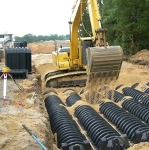Scientists could have a revolutionary new way of measuring how much of the potent greenhouse gas methane is produced by cows and other ruminants, thanks to a surprising discovery in their poo.
A collaborative effort involving public school systems, a waste hauler, a foodservice distributor, and Dart Container Corp. to recycle foam school lunch trays has hit a new milestone in California – with more than one million trays now being collected and recycled each month.
Aquaculture is the fastest growing form of food production in the world, accounting for 50 percent of all seafood consumed globally.
Children in the mountain village of Ti Peligre, Haiti, needed safe passage across a treacherous river to reach school. To help, a dozen Virginia Tech students -- determined to prevent more drownings -- designed and helped build a 200-foot bridge.
Two carbon forestry projects have reached verification status against the climate, community and biodiversity (CCB) standards, meaning that the projects have been implemented using best practices for community engagement and have generated benefits for local communities and biodiversity as well as for the climate.
CBI Polymers LLC, the innovator of DeconGel® nuclear decontaminant, will join the broad-based philanthropic effort to help with the crisis in Japan by making a donation of $250,000 in radiological decontamination products and technical services at the request of the Japanese Medical Association.
The utility could provide individuals their energy-usage information in real time, which enabled them to make informed choices to reduce their electricity demand.

When St. Augustine Prep School in Richland, N.J., decided to expand its facilities, it focused on maintaining the school’s historically strong environmental commitment. What it didn't realize, though, is that the wastewater treatment system it had implemented was unable to handle the capacity of wastewater the school generated.
Kevin Chen wants to prevent future environmental disasters caused by oil spills, and thanks to the EPA, the Polytechnic Institute of New York University sophomore is one step closer.
The owner of a New Jersey solid waste management company and three of his associates were arrested on federal charges that they conspired to transport and dump thousands of tons of asbestos contaminated debris at an upstate New York farm containing wetlands.
The voluntary carbon market shrugged off policy failures and the closure of the Chicago Climate Exchange in 2010 to post a 34 percent surge in volume to a record 131 million tons of carbon dioxide equivalent (MtCO2e) worth at least $424 million, according to a new report.
A new study concludes that models may be predicting releases of atmospheric carbon dioxide that are either too high or too low, depending on the region, because they don't adequately reflect variable temperatures that can affect the amount of carbon released from soil.
Research to map the distribution of manure on the surface of feedlots and the flow of liquid manure in rain runoff could lead to both precision harvesting of manure and also precision application of manure to crop fields, while controlling nutrient losses, gas emissions, and odors.
GE has introduced a modular version of the company’s ABMet wastewater treatment system, which uses naturally occurring microbes to reduce the selenium and other metals that can escape from coal mines and power plants and enter U.S. freshwater supplies.
The U.S. Postal Service reported an 8 percent reduction in greenhouse gas emissions from a fiscal year (FY) 2008 baseline. The reduction of 1,067,834 metric tons of carbon dioxide is an amount equal to the annual emissions of approximately 204,000 passenger vehicles.
New technologies can improve agricultural sustainability in developing countries, but only with the engagement of local farmers and the social and economic networks they depend on, say Stanford University researchers.
In a partnership with EarthShare, Garnier will award money to support a cleaner, greener future
The two organizations will establish a global standard for accounting and reporting community-scale greenhouse gas (GHG) emissions that can be used across multiple platforms.
Underwriters Laboratories has introduced testing methods to meet the monitoring requirements for 28 new contaminants proposed in the EPA’s third Unregulated Contaminant Monitoring Regulation (UCMR 3).

How far will a parent go to convince their child to stop leaving lights on around the house? For inventor and journalist Pierce Hoover, the answer is 4,000 miles.